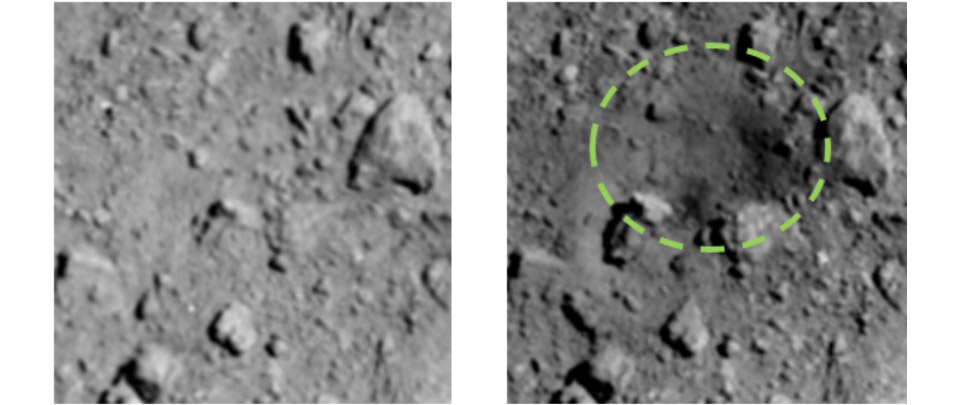
The Japan Aerospace Exploration Agency (JAXA) has been investigating an asteroid called Ryugu with their spacecraft Hayabusa2. In order to collect dust and other matter from the asteroid, Hayabusa2 shot at it with a small mass of copper to release gravel.
Now Hayabusa2 has returned closer to the asteroid to see what impact the shot had on the asteroid’s terrain.
The efforts to examine the effects of the collision were called the Crater Search Operation (CRA2) mission, and took place from April 23 to April 25. The Hayabusa2 craft descended toward the asteroid to observe the surface and what changes were made to the terrain by the impact. The lowest altitude achieved was 1.6 to 1.7 kilometers or about 1 mile from the asteroid surface. From this height, the craft used its low gain antenna (LGA) to make observations.
Having made its observations, the craft rose away from the asteroid using its thruster engine to move at a speed of about 30 cm per second until it returned to its home position for normal operation.
You can see the images that Hayabusa2 captured on its approach to the asteroid on the JAXA website.
JAXA also shared a stunning video showing the effects of the asteroid impact. “This video shows the descent of the SCI (Small Carry-on Impactor) made from images captured at 2 second intervals just after separation from Hayabusa2 by the onboard TIR (Thermal Infrared Camera),” the organization explained on Twitter. “In the background, you can see the surface of Ryugu 500m away.”
Scientists are still investigating the exact details of the crater created by the impact. The agency announced it will be examining the size and shape of the crater in future, but current estimates put the area of effected terrain at a size of around 20 meters (66 feet) across. This is larger than was expected, so scientists may have reason to rethink their assumptions about the response of the asteroid to the impact.
This information could be important to international attempts to create planetary defenses to keep the Earth safe from asteroid impacts.
Editors' Recommendations
- See photos of the sample JAXA brought back from asteroid Ryugu
- Asteroid sample returned to Earth from Japan’s Hayabusa2 spacecraft
- Spacecraft to end epic asteroid trip with special delivery for scientists
- Japanese probe prepares to return sample of asteroid to Earth
- See Hayabusa2 touch down on asteroid Ryugu and collect a sample


